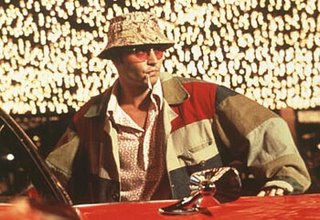Thinking back to the late 1800's when I was in high school, I recall a dress code being in the student handbook. As an angsty teen with a tenuous grasp on the First Amendment, I thought that this was tyranny of the highest order. Little did I know at the time, but the Supreme Court had taken up this issue and carved out a few rules. In
Tinker v Des Moines, the Court said that schools can limit student speech (including t-shirt speech) when the speech or expression will create a substantial disruption or invade others' rights.
Then came
Harper v Poway Unified School District. Over at the First Amendment Center, David L. Hudson Jr. has
some analysis about this interesting Ninth Circuit case. I have been meaning to write about this case. I meant to when the decision first came down. I meant to when the Ninth denied an
en banc rehearing. I have the time now, and Hudson's article is excellent, so here we go.
Using one of the rhetorical questions asked by Hudson, I'll paraphrase what happened in the case...
[T]he 9th U.S. Circuit Court of Appeals stated that school officials could prohibit student Tyler Chase Harper from wearing shirts bearing messages such as "BE ASHAMED, OUR SCHOOL EMBRACED WHAT GOD HAS CONDEMNED" and "HOMOSEXUALITY IS SHAMEFUL." Harper wore the shirts to protest his school's support of a National Day of Silence, which promotes tolerance of sexual orientation.
Harper sued, claiming that the school's silencing of his expression amounted to viewpoint discrimination because the school allowed expression of what Harper considered the pro-gay viewpoints associated with the Day of Silence
Writing for the majority, Judge Stephen Reinhardt claimed that Harper's shirt invaded the rights of the other students. I'm still not exactly sure what constitutes an invasion of rights. Reinhardt seems to think that offending someone greatly is enough. In dissent, Judge Alex Kozinski stated "I have considerable difficulty with giving school authorities the power to decide that only one side of a controversial topic may be discussed in the school environment because the opposing point of view is too extreme or demeaning."
There is the interesting issue here. The school decided to endorse the National Day of Silence, taking a side in a social issue. They then decided to restrict the speech of Harper, who ended up spending the rest of the day in the office because of his shirt.
Hudson quotes the most head-shaking part of this case, the
en banc denial concurrence written by Reinhardt...
In his concurrence to the denial of en banc review, Reinhardt wrote that "the dissenters still don't get the message - or Tinker!" He wrote: "Whatever the reason for the dissenters' blindness, it is surely not beyond the authority of local school boards to attempt to protect young minority students against verbal persecution, and the exercise of that authority by school boards is surely consistent with Tinker's protection of the right of individual students 'to be secure and to be let alone.'"
Judge Reinhardt once again shows his two most prominent qualities: arrogance and being wrong. He excells in both fields. His little "I'm right, you're wrong!" temper tantrum is very cute.
Ninth Circuit conservative stalwart Judge Diarmuid O'Scannlain fired back at Reinhardt...
Several judges voted to rehear the case, including Judge Diarmuid O'Scannlain, who wrote that "the panel majority's decision amounts to approval of blatant viewpoint discrimination." He reasoned that "under the panel majority's decision, school administrators are now free to give one side of debatable public questions a free pass while muzzling voices raised in opposition."
O'Scannlain sees this decision as being dangerous precedent. If it stands, schools can take sides in social issues like this, then restrict or punish students that choose to voice opinions that conflict with the school's stance. How far will this power of the schools go?
Harper's attorney will decide in the next week whether or not to appeal the case to the Supreme Court. I have no idea why he wouldn't do it. I think that Reinhardt's view of
Tinker is incredibly wrong, and the Court is not going to let this stand. If other circuits bought into the reasoning in this case, it could cause major restrictions of free speech in schools everywhere. Hudson seems to agree...
[I]t involves an unusual application of the Tinker standards. The vast majority of cases applying Tinker have focused on the "substantial disruption" standard, whereas the Harper v. Poway panel opinion seized on the oft-ignored Tinker language of "invasion of the rights of others." Lower courts need guidance on the application of this part of Tinker.
The "invasion of the rights of others" language is insanely broad and squishy. The Court needs to create some guidelines about this language or judges like Reinhardt are going to have a field day with it.


